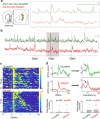Accumbens cholinergic interneurons dynamically promote dopamine release and enable motivation
- PMID: 37272423
- PMCID: PMC10259987
- DOI: 10.7554/eLife.85011
Accumbens cholinergic interneurons dynamically promote dopamine release and enable motivation
Abstract
Motivation to work for potential rewards is critically dependent on dopamine (DA) in the nucleus accumbens (NAc). DA release from NAc axons can be controlled by at least two distinct mechanisms: (1) action potentials propagating from DA cell bodies in the ventral tegmental area (VTA), and (2) activation of β2* nicotinic receptors by local cholinergic interneurons (CINs). How CIN activity contributes to NAc DA dynamics in behaving animals is not well understood. We monitored DA release in the NAc Core of awake, unrestrained rats using the DA sensor RdLight1, while simultaneously monitoring or manipulating CIN activity at the same location. CIN stimulation rapidly evoked DA release, and in contrast to slice preparations, this DA release showed no indication of short-term depression or receptor desensitization. The sound of unexpected food delivery evoked a brief joint increase in CIN population activity and DA release, with a second joint increase as rats approached the food. In an operant task, we observed fast ramps in CIN activity during approach behaviors, either to start the trial or to collect rewards. These CIN ramps co-occurred with DA release ramps, without corresponding changes in the firing of lateral VTA DA neurons. Finally, we examined the effects of blocking CIN influence over DA release through local NAc infusion of DHβE, a selective antagonist of β2* nicotinic receptors. DHβE dose-dependently interfered with motivated approach decisions, mimicking the effects of a DA antagonist. Our results support a key influence of CINs over motivated behavior via the local regulation of DA release.
Keywords: acetylcholine; approach; dopamine; motivation; neuroscience; rat; striatum.
© 2023, Mohebi et al.
Conflict of interest statement
AM, VC, JB No competing interests declared
Figures





Comment in
-
Comment on 'Accumbens cholinergic interneurons dynamically promote dopamine release and enable motivation'.Elife. 2024 May 15;13:e95694. doi: 10.7554/eLife.95694. Elife. 2024. PMID: 38748470 Free PMC article.
References
-
- Al-Hasani R, Gowrishankar R, Schmitz GP, Pedersen CE, Marcus DJ, Shirley SE, Hobbs TE, Elerding AJ, Renaud SJ, Jing M, Li Y, Alvarez VA, Lemos JC, Bruchas MR. Ventral Tegmental area GABAergic inhibition of cholinergic interneurons in the ventral nucleus accumbens shell promotes reward reinforcement. Nature Neuroscience. 2021;24:1414–1428. doi: 10.1038/s41593-021-00898-2. - DOI - PMC - PubMed

